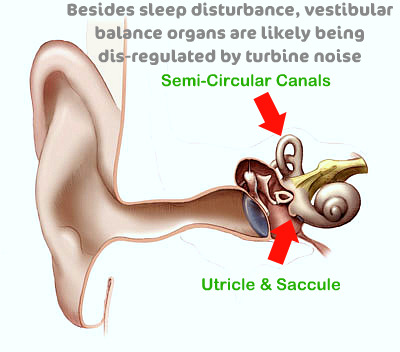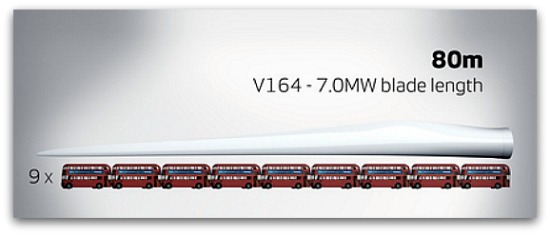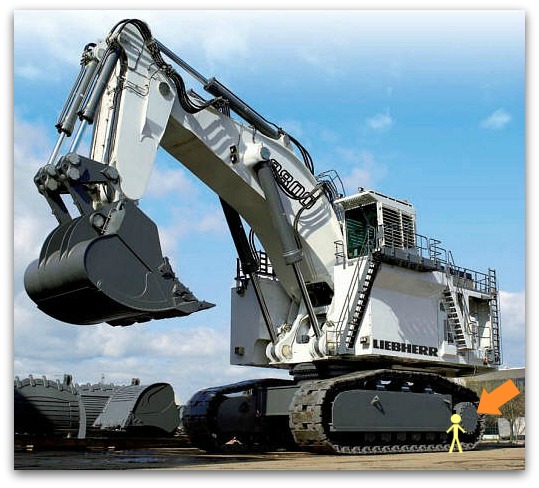Size matters! Yikes!
Jul 10, 2011
·
—Calvin Luther Martin, PhD
·
Just when you thought you’d seen everything …
·
The new Vestas164-7.0 MW blade (courtesy of windpowermonthly.com)
·
Don’t bother getting out your calculator: 80 meters = 262 feet. But remember, that’s only 1 of 3 blades.
Here’s all the statistics on the V164 7MW:
- swept area 21,124 square meters (227,319 square feet = 5.2 acres = 4 National Football League football fields with both 30-foot end zones included)
- blade length 80 meters (262 feet)
- minimum hub height 105 meters (344 feet to nacelle from the ground)
- rotor diameter 164 meters (538 feet)
- tip height 187 meters (614 feet)
- weight 800 tons
What does 800 tons look like? It looks like this.
·
·
Now, read “The bigger they are, the more low frequency noise.”
·
 ·
·
Vestas says these monsters are for offshore use. Maybe.
Problem is, if you look at the history of industrial wind turbine installation, you soon discover that what we all thought were monsters “back then” were designed either for remote places (i.e., not in your backyard) or out at sea or giant lakes.
Guess what? They wound up in someone’s backyard. Lots of backyards.
The take-home message being: If Big Wind can finagle putting these “goliaths” in your backyard, chances are very good they’ll do it.
How do they finagle that? By continuing to deny infrasound/low frequency noise, by continuing to claim these machines are as quiet as a babbling brook or refrigerator, and by continuing to bombard government at all levels with the Chicken Little message that planet earth needs these structures, everywhere (read: “your backyard”), to save us from Global Warming. And, of course, by merely moving them back a bit further (setback), to, say, 2000 or 3000 feet.
So it goes. (And if you insist on believing Big Wind—that these suckers ain’t gonna wind up in people’s backyards—I’ve got a bridge to sell you in Brooklyn. . . .)
Or your backyard, where your neighbor (often an absent property owner) has signed a “sweet” turbine deal for 20 years, renewable up to 50. (By the way, your town supervisor or a close relative of his has also signed a lease, which is why the supervisor thinks these wind machines are just the ticket for your township.)
»»»»
My friends, you’re looking at the new Big Idol. The new Golden Calf (of Hebrew tradition). The new Sphinx. From ancient mythology—a mythology which has not died, by the way. It never died.
“History” is not over; the past is not dead. It never was. This kind of mentality—colossal, planet-saving machines—is deeply woven into the fabric of western history.
For the more scholarly among you, I strongly recommend reading Norman Cohn, Cosmos, Chaos and the World to Come: The Ancient Roots of Apocalyptic Faith (New Haven & London: Yale Univ. Press, 1993)—a peer-reviewed book, incidentally. I also recommend my own, In the Spirit of the Earth: Rethinking History & Time (Baltimore: Johns Hopkins University Press, 1992)—likewise peer-reviewed prior to publication. (Credentials check: I was a tenured professor of history at Rutgers University for decades. I wrote the “best book in American history” in 1978, as judged by the American Historical Association. I have been a National Endowment for the Humanities Senior Fellow and a John Simon Guggenheim Fellow. I know what I’m talking about, here.)
 William Butler Yeats
William Butler Yeats
The Irish poet W.B. Yeats captured the message in “The Second Coming.”
Turning and turning in the widening gyre
The falcon cannot hear the falconer;
Things fall apart; the centre cannot hold;
Mere anarchy is loosed upon the world,
The blood-dimmed tide is loosed, and everywhere
The ceremony of innocence is drowned;
The best lack all conviction, while the worst
Are full of passionate intensity.Surely some revelation is at hand;
Surely the Second Coming is at hand.
The Second Coming! Hardly are those words out
When a vast image out of Spiritus Mundi
Troubles my sight: somewhere in sands of the desert
A shape with lion body and the head of a man,
A gaze blank and pitiless as the sun,
Is moving its slow thighs, while all about it
Reel shadows of the indignant desert birds.
The darkness drops again; but now I know
That twenty centuries of stony sleep
Were vexed to nightmare by a rocking cradle,
And what rough beast, its hour come round at last,
Slouches toward Bethlehem to be born?
·




Comment by Sue Hobart (Falmouth, Mass.) on 07/10/2011 at 9:39 pm
I was hoping to live a bit longer, but that hope is rapidly diminishing …
Comment by Parn Supeen (Mass.) on 07/11/2011 at 10:55 am
Actually, this model is designed for offshore use, as the linked article makes clear in its headline. However, Vestas does have a new extra-large onshore model: the 3-MW V112. The blade diameter is 112 meters, or 367.5 feet, for a sweep area of 9,852 square meters, or 2.43 acres.
Editor’s note: After you wrote your note, I edited my piece to address the “offshore use” claim by Vestas.
Comment by Brad Blake, Cape Elizabeth, ME on 07/11/2011 at 11:14 am
Noise aside, I wonder how far apart these behemoths must be placed to avoid turbulence with one another?
Will we in Maine need to start saying 1,000 miles of mountains and ridges destroyed instead of 350 miles in order to meet the state’s arbitrary and senseless goal of installed capacity of wind (non)power?
It’s disgusting!
Comment by Tom Whitesell (NY State) on 07/11/2011 at 11:16 am
How big is too big?
How dumb is too dumb?